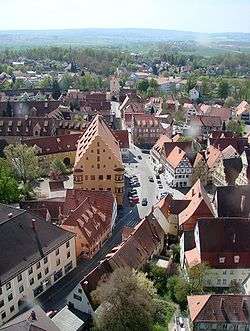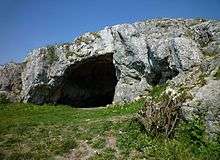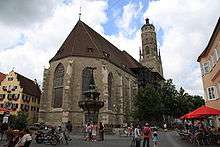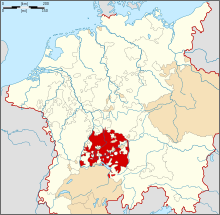Nördlingen
Nördlingen (German: [ˈnœʁt.lɪŋ.ən] (![]()
Nördlingen | |
|---|---|
 Nördlingen, south view from the church tower Daniel | |
 Coat of arms | |
Location of Nördlingen within Donau-Ries district  | |
 Nördlingen  Nördlingen | |
| Coordinates: 48°51′4″N 10°29′18″E | |
| Country | Germany |
| State | Bavaria |
| Admin. region | Swabia |
| District | Donau-Ries |
| Government | |
| • Lord Mayor | David Wittner (PWG) |
| Area | |
| • Total | 68.10 km2 (26.29 sq mi) |
| Elevation | 441 m (1,447 ft) |
| Population (2018-12-31)[1] | |
| • Total | 20,379 |
| • Density | 300/km2 (780/sq mi) |
| Time zone | CET/CEST (UTC+1/+2) |
| Postal codes | 86720 |
| Dialling codes | 09081 |
| Vehicle registration | DON, NÖ |
| Website | www.noerdlingen.de |
Another attraction in the town is Saint George's Church's 90 m steeple, called "Daniel", which is made of a suevite impact breccia that contains shocked quartz. Other notable buildings are the town hall (which dates to the 13th century), St. Salvator church and the Spital, a former medieval hospital. The Ries crater museum is located in the well-preserved medieval tanner's quarter.
The city is home to several other museums, such as the Bavarian Railway Museum, the Nördlingen city museum (Stadtmuseum), the city wall museum (Stadtmauermuseum) and Augenblick museum with panoramas, magic lanterns, silent films, barrel organs, pianolas, music boxes and gramophones.
Nördlingen is also known for the Scharlachrennen, a horse riding tournament that was first mentioned in 1463.
The Nördlingen town was used as the filming location for the film Willy Wonka and the Chocolate Factory.
History
Prehistory and Celtic period

Finds in the Ofnet Caves near the city show that the site of present-day Nördlingen was already inhabited in the late Palaeolithic. In the Large Ofnet, in 1908 archaeologist R. R. Schmidt found two dish-shaped pits in which human skulls were lying "like eggs in flat baskets".[3] In the larger pit were 27 skulls and in the other there were 6 skulls.[4] The skulls were arranged concentrically with their faces turned towards the setting sun.[4] They were all covered with a thick layer of red ochre.[4] The skulls have been dated to the 7th millennium BC.[5] In the area around Nördlingen, additional sites dating to almost all of the subsequent prehistoric epochs have been discovered. Particularly important was an area on the eastern edge of the district Baldingen, where settlements have been found belonging to the Neolithic Linear Pottery culture, the Bronze Age Urnfield culture, and the Celtic Iron Age Hallstatt and La Tène cultures.
Roman Empire
The area which includes present-day Nördlingen was part of the Roman province of Raetia,[6] but little research has been conducted on the city's Roman period. A Roman villa has been excavated in the district of Holheim, and can be visited today. Another villa with an adjoining burial ground has been identified in the Baldingen district. A settlement (vicus), built in 85 C.E., occupied the southern part of the city until 259-260 C.E., when it was destroyed during the conquest of what is now southern Germany by the Germanic-speaking Alemanni tribes. The Roman settlement may have been the one known as Septemiacum, which is supposed to have been built between 80-300 C.E.,[7] although it is possible that this particular settlement was actually located at a different site such as Oberdorf,[8] leaving the name of the settlement at Nördlingen uncertain.
Middle Ages
The Alemannic people occupied the Nördlingen area during the 6th and 7th centuries C.E., during which time the region was gradually Christianized under the Merovingian dynasty, and several burial grounds from this period have been discovered. The name "Nordilinga" is first found in documents of the Carolingian royal court dating from 898 C.E., and the city today celebrates this as the date of its "foundation". Under the rule of the Bishops of Regensburg, Nördlingen grew into an important market town.
In 1215, Nördlingen was granted city rights by Emperor Frederick II and became imperial city of the Holy Roman Empire. In that year, the first city wall was built, whose floor plan is still visible today. In a document dating to 1219, the Nördlinger Pfingstmesse ("Nördlinger fair") was first mentioned, an event which continues as a folk festival in the city to the present day. Thanks to Nördlingen's location at the crossroads of two major trade routes (Frankfurt / Würzburg-Augsburg and Nuremberg-Ulm), became an important trading center for grain, livestock, textiles, furs, and metal goods. Besides Frankfurt, Nördlingen was one of the most important long-distance trade fairs in the region.
In 1238, a fire destroyed much of Nördlingen, but the city quickly recovered. Three generations later, a large number of craftsmen, especially tanners and weavers, settled outside the city walls. In 1327 the present-day circular wall was built, which increased the size of the walled portion of the city fourfold. 1427 saw the start of construction on St. George's Church.
In the year 1472 the lawsuit against the brothel owners Linhardt Freiermuth and his wife Barbara Taschenfeind are recorded in the court records of the city. The starting point of the trial was the charge of forced abortion on the prostitute Els von Eystett. The court convicted the owners and banished the husband from the city. His wife was branded on the forehead and pilloried. The 40 parchment pages in the city archive of Nördlingen for this trial give a unique insight into the conditions of a brothel in this time period.
Early modern period


In 1529, the city was part of the Protestation at Speyer, which sought to allow the unimpeded spread of the Protestant Reformation. In 1555, the Reformation in Nördlingen was finally completed. In 1579, Mayor Peter Seng (1512-1589) signed the Lutheran Formula of Concord.
The witch trials in the early modern period in Nördlingen have been well documented. Between 1589 and 1598, 34 women and one man were burned at the stake for the crime of witchcraft, and one co-defendant midwife, Barbara Lierheimer, died while in custody. The trials of Maria Holl and Rebecca Lemp became especially well-known.[9] In 1589, Pastor Wilhelm Friedrich Lutz delivered sermons against the radical witch persecution of Nördlingen City Council, prior to the Council's execution of the first alleged witches in May 1590. One of the three women executed in that year was a carter's daughter, Ursula Haider, who was arrested on 8 November 1589 and burned on 15 May 1590. The trial of Ursula Haider was by described by Ulrike Haß in her book Teufelstanz.
It is often said that in 1604 a shortened and simplified version of William Shakespeare's Romeo and Juliet was performed in Nördlingen and that this was one of the first performances of any Shakespearean play outside England.[10] In fact, the players applied to perform but were denied by the local authorities and were compensated for their efforts.[11]
Nördlingen served as the site of two historic battles, and marked a turning point in the Thirty Years' War. In the first Battle of Nördlingen in 1634, the Swedish Protestant forces were decisively defeated for the first time by the imperial Habsburg troops. The city was compelled to open its gates to the victors, but was not plundered by the victorious troops after high reparations payments. However, during and after the siege, the city lost more than half of its population due to hunger and illness. This was exacerbated by the second Battle of Nördlingen in 1645, and it would not be until 1939 that Nördlingen regained the population it had in 1618. In the early 18th century, during the War of the Spanish Succession, the city was further affected by the impact of nearby battles of Höchstädt. The wars forced trade to shift to the seaports, and as a result, Nördlingen lost its importance as a trading center. In part due to this forced economic standstill, Nördlingen's medieval cityscape remained well preserved.
As a result of the German mediatization, in 1803 Nördlingen lost its status as an imperial city and became part of the Electorate of Bavaria, which had occupied the city in September 1802 in anticipation of the decree. On January 1, 1806, Bavaria's Elector declared himself king, officially changing the Electorate of Bavaria into the Kingdom of Bavaria, which seceded from the Holy Roman Empire the following August.
Modern period

On May 15th 1849, Nördlingen was connected to the network of the Royal Bavarian State Railways. In that same year, the first rail lines opened to Nuremberg. A third railway connection, under the leadership of the Royal Württemberg State Railways, was opened on 3 October 1863 to Aalen.
During the Second World War, a total of 33 people were killed in and around Nördlingen by air raids conducted in the spring of 1945. The train station and several houses were destroyed, and St. George's Church was severely damaged. However, most of the historic district of the city was spared. In 1945, Nördlingen became part of the American occupation zone of Allied-occupied Germany. The United States military set up a displaced persons (DP) camp in the city. The camp was overseen by UNRRA and housed approximately 500 DPs, mostly from Latvia and Lithuania. More than 4,500 people settled permanently in Nördlingen after the war.
Since the Middle Ages, Jewish families have resided in Nördlingen. They buried their dead in the Jewish cemetery on Nähermemminger Way, and a synagogue was built in 1885. The synagogue was destroyed by the Nazis during the November pogrom of 1938, and this is commemorated by a plaque on today's Protestant parish hall. In 1979, a memorial stone was erected in the Jewish cemetery commemorating Jewish victims of the Holocaust.
In the course of the municipal reorganization of Bavaria, Nördlingen lost its status as a city on July 1, 1972 and was incorporated into the newly formed district Nördlingen-Donauwörth, which received its current name, Donau-Ries, on May 1, 1973.
Mayors

| Name | Term of office |
|---|---|
| Wilhelm Brunco | 1914–1916 |
| Otto Mainer | 1916–1927 |
| Wilhelm Hausmann | 1927–1939 |
| Heinrich Schulz | 1939–1941 |
| Eugen Einberger | 1941–1944 |
| Paul Söldner | 1945–1946 |
| Josef Feil | 1946–1948 |
| Johannes Weinberger | 1948–1964 |
| Hermann Keßler | 1964–1982 |
| Paul Kling | 1982–2006 |
| Hermann Faul | since 2006 |
Economy
Important companies in Nördlingen are:
- Strenesse – fashion
- C.H. Beck – book publisher
- Varta – battery manufacturer
- Maierbier – brewery
Nördlingen has a station on the Ries Railway, which is served hourly on weekdays.
Sport
The local sports club, the TSV 1861 Nördlingen, has a very successful basketball department with the men's and the women's team both in the Basketball Bundesliga. The clubs football team is traditionally the strongest side in northern Swabia. Its most successful former player is Gerd Müller, who was born and raised in Nördlingen. Its stadium was renamed in his honour in 2008.
Impact diamonds
Stone buildings in the town contain millions of tiny diamonds, all less than 0.2 millimetres (0.0079 in) across. The meteorite impact — from a 1-kilometre-wide (0.62 mi) asteroid — that caused the Nördlinger Ries crater created an estimated 72,000 tonnes (71,000 long tons; 79,000 short tons) of them when it impacted a local graphite deposit. Stone from this area was later quarried and used to build the stone buildings.[2]

Culture
Ikuko Itoh anime series Princess Tutu 2002
the Japanese manga and anime series Shingeki no Kyojin 2013
International relations
Twin towns – sister cities
Nördlingen is twinned with:[12]
.svg.png)
.svg.png)


Notable residents
.jpg)
- Friedrich Herlin (born c. Around 1430, † around 1500), painter of late Gothic
- Bartholomäus Zeitblom (born c. 1455, † c. 1518), painter of late Gothic
- Albrecht Adam (1786–1862), war artist
- Heinrich Adam (1787–1862), painter, member of the painter family Adam from Nördlingen
- Johann Michael Voltz (1784–1858), a graphic artist and painter
- Friedrich Voltz (1817–1886), painter
- Otto Förschner (1902–1946), Nazi concentration camp Dora-Mittelbau commandant in Landsberg executed for war crimes
- Christel DeHaan (born 1942), American businesswoman and philanthropist, former owner of Resort Condominiums International, founder of Christel House International[13]
- Gerd Müller (born 1945), football player and coach, as "Bomber of the Nation" a well-known football player
- Anton Meyer (born 1955), economist and professor of business administration
- Sabine Haubitz (born 1959), art photographer
- Michael Lutz (born 1982), football player
- Stefan Rieß (born 1988), football player
- Steffen Lang (born 1993), footballer
See also
- Rintfleisch-Pogrom
- Master of Nördlingen, whose name is derived from the town
- Henry of Nördlingen
- Herkheim, a community within Nördlingen
Notes
- "Fortschreibung des Bevölkerungsstandes". Bayerisches Landesamt für Statistik und Datenverarbeitung (in German). July 2019.
- "The ancient town with a history from outer space". BBC. 2 March 2020.
- Oliva, Martin (2005). Palaeolithic and Mesolithic Moravia. Moravian Museum. p. 112.
- Onians, R. B. (1988). The Origins of European Thought. Cambridge University Press. p. 541. ISBN 0521347947.
- Whittle, A. W. R. (1996). Europe in the Neolithic: The Creation of New Worlds. Cambridge University Press. p. 153. ISBN 0521449200.
- http://vici.org/vici/18421/?lang=de
- Czysz, Wolfgang. Die Römer in Bayern. Nikol, 2005. ISBN 3937872116, 9783937872117. 594 pages.
- Bender, H. "Places: 123119 (Septemiacum)". Pleiades. Retrieved August 19, 2018.
- "Archived copy" (PDF). Archived from the original (PDF) on 2015-07-23. Retrieved 2018-08-19.CS1 maint: archived copy as title (link)
- Dawson, Anthony B. (2002). "International Shakespeare". In Wells, Stanley; Stanton, Sarah. The Cambridge Companion to Shakespeare on Stage. Cambridge: Cambridge University Press. pp. 174–193. ISBN 978-0-521-79711-5, p. 176
- Oppitz-Trotman, George. (2015). Romeo and Juliet in German, 1603-1604" Notes and Queries 260: 96-98.
- "Partnerstädte". noerdlingen.de (in German). Nördlingen. Retrieved 2019-12-04.
- "Christel DeHaan". Forbes. Retrieved 13 March 2017.
References
- Emsley, John (2001). NATURE'S BUILDING BLOCKS. Oxford University Press, pp. 99. ISBN 0-19-850341-5.
- Baier, Johannes (2007): Die Ausfwurfprodukte des Ries-Impakts, Deutschland, 'in Documenta Naturae, Vol. 162, München. ISBN 978-3-86544-162-1
- Baier, Johannes (2008): Zur Herkunft der Suevit-Grundmasse des Ries-Impakt Kraters, in Documenta Naturae, Vol. 172, München. ISSN 0723-8428
- Theodor Heuss: Reiz biedermeierhafter Idylle. Besuch in Nördlingen. In: Die romantische Straße. Merian, 7. Jg., Heft 12/1954, S. 34–41.
- Wolfgang Kootz (Text), Willi Sauer, Ulrich Strauch u. a. (Fotos): Nördlingen im Ries an der Romantischen Straße, Stadtführer mit 90 Farbbildern, Kraichgau Verlag, 2007, ISBN 978-3-929228-47-2.
- Dietlof Reiche: Der Bleisiegelfälscher. Beltz & Gelberg, 1998, ISBN 978-3-407-78781-1 (Historischer Roman, ausgezeichnet mit dem Kinder- und Jugendbuchpreis der Stadt Oldenburg 1977 und mit dem Deutschen Jugendbuchpreis 1978. In diesem Jugendbuch wird die mittelalterliche Situation der Nördlinger Lodenweber sehr eingehend beschrieben.)
- Dietlof Reiche: Die Hexenakte. Carl Hanser, 2007, ISBN 978-3-446-20860-5; dtv, 2009, ISBN 978-3-423-62387-2 (Historischer Roman (Jugendroman) zur Hexenverbrennung und -verfolgung in Nördlingen; beruht auf der Geschichte Reiches eigener Vorfahrin).
- VII. 90/2: Bernd Vollmar, Georg Paula, Catharina Kociumaka: Stadt Nördlingen, mit Beiträgen von Wolfgang Czysz, Hanns Dietrich, Gerhard Ongyerth und Dietmar-H. Voges und Aufnahmen von Vera Sohnle. Photohaus Finck, Dieter Komma, 1998, ISBN 3-87490-578-0.
- Wolfgang Wüst: Wider Gotteslästerung, Unkeuschheit, Ehebruch, Neid, Hass und Aufruhr – Policey und Zucht in Nördlingen im Jahre 1542/43. In: Zeitschrift des Historischen Vereins für Schwaben (=ZHVS) 109 (2017), ISBN 978-3-95786-110-8, S. 167–187.
- Gustav Adolf Zipperer: Wege durchs Ries. Ein Wanderführer. Fränkisch-Schwäbischer Heimatverlag, Donauwörth 1975.
External links
| Wikimedia Commons has media related to Nördlingen. |
| Wikivoyage has a travel guide for Nördlingen. |
- Official website
- . Encyclopedia Americana. 1920.
- (in German) Noerdlingen — a Bavarian town in a crater, website with further information and some pictures
- (in German) Scharlachrennen Nördlingen


